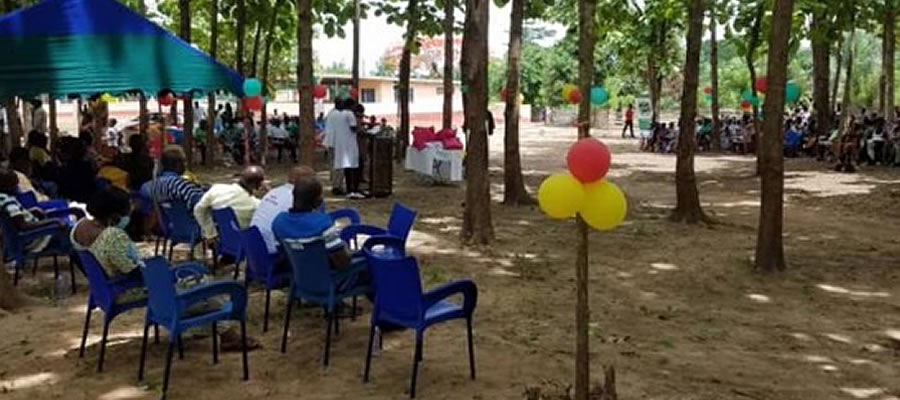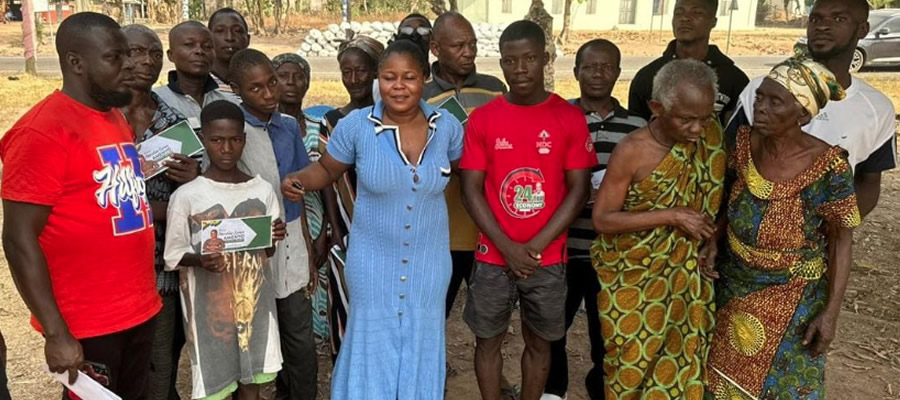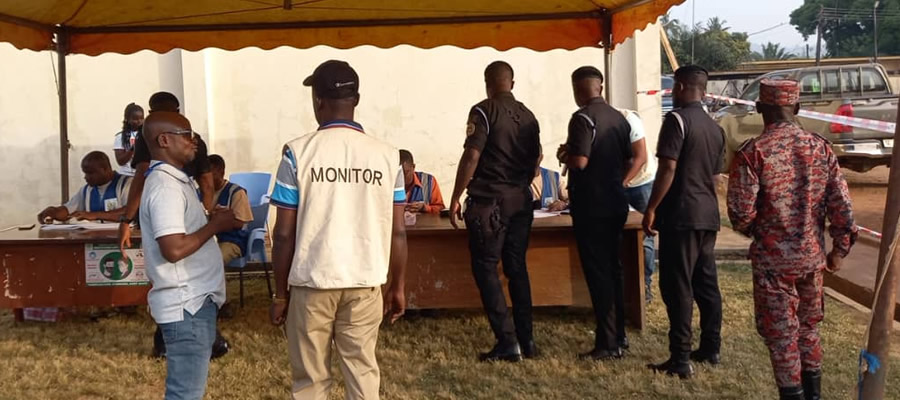

Population
Hohoe Municipal was created in 1979 after being couched out of the part of the ’old’ Jasikan and Kpandu District Councils. The first schedule of the L.I 1462 which established the present Hohoe Municipal Assembly lists out the number of settlements that come under its jurisdiction.
Ethnicity Communities in the Hohoe Municipality
The major ethnic groups in the Municipality are Ewes, Akpafu/Lolobi, Santrokofi, Likpe, Logba, Tafi and Nyagbo.
Major Ethnic Groups in the Hohoe Municipality | |||||
EHTHNIC GROUP | LANGUAGE | 1995
| 2000
| ||
|
| POPULATION | % | POPULATION | % |
Ewe | Ewe | 95,497 | 66.47 | 104,664 | 66.04 |
Akpafu | Siwu | 8,158 | 5.67 | 8,964 | 5.65 |
Lolobi | Siwu | 7,100 | 4.94 | 7,815 | 4,93 |
Santrokofi | Sele | 4,687 | 3.26 | 5,851 | 3.69 |
Likpe | Sekpele | 14,286 | 9.94 | 15,699 | 9.9 |
Logba | Ikpana | 6,727 | 4.68 | 7,334 | 4.62 |
Tafi | Tegbor | 3,629 | 2.52 | 4,212 | 2.65 |
Nyagho | Tutrugbu | 3,582 | 2.49 | 3,938 | 2.48 |
The 1984 census, which was conducted later could not have anticipated and respected the collation as done under the L.I. 1462. After making allowances for settlements identified from the population figures of Jasikan and Kpandu , the 1984 population accepted for the study was 115,580.
The National Water Supply and Sanitation Survey conducted by the rural Water Supply Department of G.W.S.C. for the Assembly and sponsored by the UNICEF in 1992 came out with population figures which corroborates the corrected figure and established a growth rate is at 1.9%.
The 2000 population figure for Hohoe Municipal (based on DSDA II headcount) is 144,511 with the gender breakdown established as 70,754 males and 73,547 females, (ref. Table 2).
Judging from the number of settlements that have attained the 5000 population mark, the conclusion to be drawn is that the Municipality is essentially a rural one. No other single settlement supports Hohoe as an urban center. This is peculiar, noting that the population of Hohoe town (i.e.: 32.000. 1995) far outstrips the rest of the settlements in the district.
This situation occasions a peculiar type of migration and establishes a skewness in development with a "pulling effect" favouring Hohoe. Regarding the status of Hohoe town in the national matrix of settlements hierarchy and grading, (ie. grade 2) it is very important to address the issue raised above by establishing a number of urban settlements within the Municipality’s framework to give Hohoe township the required intermediate support.
National projections stand to fail if the current big gap between Hohoe town and its rural set-up is allowed to persist. Although the settlements, as indicated in table 3 have been selected as centers for the 13 urban/area council areas, their threshold populations may not be able to support the services they will be required to render to their areas of jurisdiction.
In addition to the above, there are other developing settlements whose current status as traditional administrative centers and/or market centers are likely to compete and possibly distort the development dynamics of the district. Hohoe Assembly has 21 paramountcies within its 13 Urban/Area Councils.
MUNICIPAL POPULATION DENSITY/RURAL-URBAN SPLIT
The population densities for 1960, 1970 and 1984 cannot be taken to have any significance on trends since the present constitution of the Municipality did not exist during those previous years. However the current estimate of 123 per sq km is quite high comparing with other districts in the region and the national average. To consider that the effective land area available is diminished by the highlands, the density issue becomes more significant.
Sex Distribution by Area/Urban Council | |||
Name of Area/Urban Council |
Sex | Total | |
| Male | Female |
|
Likpe | 8245 | 8227 | 16,472 |
Leklebi | 2262 | 2253 | 4,515 |
Have/Nyagbo | 4727 | 5060 | 9,787 |
Lolobi | 2180 | 2242 | 4,422 |
Hohoe Urban | 12,827 | 13,454 | 26,281 |
Liati/Afadjato | 3375 | 3466 | 6,841 |
Ve | 6894 | 7177 | 14,071 |
Gbi South | 4508 | 4668 | 9,176 |
Logba/Tafi | 5578 | 5607 | 11,185 |
Akpafu/Sanko | 5023 | 5242 | 10,265 |
Agumatsa | 6085 | 6289 | 12,374 |
Weto | 4614 | 4883 | 9,497 |
Alavanyo | 4736 | 4979 | 9,714 |
TOTAL | 71,054 | 73,457 | 144,511 |
The rural/urban split of the population also gives another dimension to the peculiarity of the population distribution. From the figures as presented in table 4, the trend has remained relatively the same for the 35 years period (1960-95). This signifies stagnancy in the economic structure of the Assembly and the low level of development.
The trend in the country depicts an increased urbanization while the relative impact is not noticed in the region or the Municipality .A further observation using the population distribution by economic activities involving the 11 leading settlements buttresses the stagnant state of the economy (see Table 5). Within the period 1960-1995 composition of population distribution by economic activities show no significant change and the relative concentration in Hohoe of the urban activities indicates an entrenchment of the status quo.
Among the leading settlements the structure of production, at constant 1975 prices has remained relatively unchanged for 11 years. The percentage share ot’GDP has ranged from 65 to 70 for Agriculture; 10-15 for Industry and 20-21 for services. Interestingly, all the leading settlements are located in the northern part of the district and within 20km radius of Hohoe.
HOUSEHOLD CHARACTERISTICS
The study defines household as a person/group of persons living and staying together and sharing the same catering arrangements (see GL.SS 3/Ghana Statistical Service 3). The average household size is 4.4 (the urban figure is 4.3 and the rural 4.6). Comparative national average size for urban and rural areas are 4.3 and 4.9 respectively.
The total number of households in Hohoe Municipality stands at 32844 (1995 est). This splits into 10226 and 22618 female headed and male headed households respectively. Households numbering 7172 lived in the urban areas while the rest 25672 were in the rural areas. Of the total number of households, 24042 representing 73.2% were with children and 8802 (26.8%) were without children
Household Income/Expenditure
Table 6 and 7 give details of annual household and per capita expenditure and income of the Assembly. The study preferably used the expenditure patterns as a basis of assessing the income status of the Assembly. The difference between the income and expenditure patterns explains the volume of transfers and remittances the households receive from outside their main sources and signifies a situation of’ no savings’.
The level of income and expenditure of the Assembly gives an indication that the potential for development exists and the right management will determine the take-off. The table indicates also that about 20% of the population accounts for almost 75% of the total expenditure are found in the urban areas.
Spatial Analysis
The study of the existing hierarchy and distribution of services in the district shows imbalances in their spatial distribution. It indicates a concentration in Hohoe. This is influenced by the simultaneous concentration of population and other economic opportunities. The former itself induces the latter.
The implication here is that potential natural resources areas are deficient in services and may hinder the attraction of population and investments.
The need for services in these resourceful areas to attract population and investment cannot be over- emphasized. It is imperative therefore to consciously ensure that the service needs of these areas in Municipality are met.
Policy objectives should therefore aim at evolving a network of services which meet the fundamental requirements of wide dispersal of service facilities, efficiency in terms of both cost and quality and concentrated in specific locations. This territorial dispersal of service facilities should be intended to reach out to the large number of small investors/producers scattered over the Municipality with little or no transportation facilities
Date Created : 11/21/2017 1:23:23 AM












 facebook
facebook
 twitter
twitter
 Youtube
Youtube
 +233 593 831 280
+233 593 831 280 0800 430 430
0800 430 430 GPS: GE-231-4383
GPS: GE-231-4383 info@ghanadistricts.com
info@ghanadistricts.com Box GP1044, Accra, Ghana
Box GP1044, Accra, Ghana